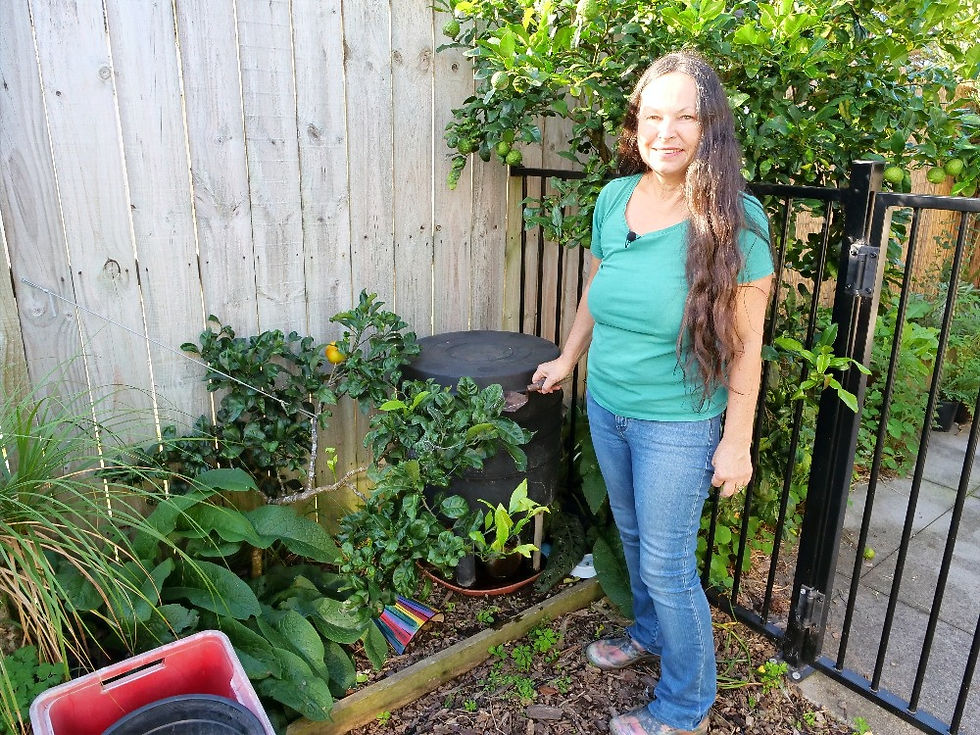The beginners guide to no-dig vegetable gardening
- Toni Kenyon

- Feb 19, 2021
- 4 min read
Updated: Feb 22, 2021

Why did I choose no-dig gardening for my small urban plot? Mainly because we had no top soil and a scraped bare patch of land to begin with.
You might have a patch of lawn or weeds that you want to convert to a productive vegetable or herb garden. No dig is the perfect solution.
I had a couple of dogs who were mud-bathing, so we covered our bare earth with grass while we watched the site (permaculture principles in action) and worked out where we wanted our no-dig bed.
Fast-forward to nearly seven years later and we no longer have lawn and we have productive garden beds that have never been dug.
What is no-dig gardening?
No Dig is exactly what it says. In nature, rich soil accumulates naturally under a layer of mulch material (usually provided by fallen leaves and dead weeds). It avoids disrupting the natural fungi, worms and micro-organisms that reside in the earth. These 'goodies' do all the hard work for me, turning the dead layers on top of the ground into vibrant, nutrient rich material that my vegetables, fruit trees and herbs thrive in.
How to get started with no-dig gardening
If you're going to grow vegetables, choose a sunny spot in the garden. One that gets at least six hours of sun a day.
If it's weedy or grassy, simply mow the grass or weeds and leave them in place.
Find some cardboard or thick layers of newspaper (not the glossy kind) and soak them in water. If the cardboard has tape on it, remove the tape.
Lay the wet newspaper/cardboard over the ground. This will smother any growth and give the worms something to munch on.
Throw anything else you have available on top of the cardboard. This is your 'mulch layer'. I like to use chicken poop, kitchen scraps (not meat--we don't eat meat--but you might) you don't want to attract vermin. You can pretty much use anything that's going to rot down. Soiled straw, any old composting materials or grass clippings that you might have around. Ask around the neighbours. If you live near the sea, you an add seaweed. Or if you have nothing else, order in a load of wood chips and spread those. You'll have an immediate forest floor.
Your mulch layer should be around 10-12 cm deep (4-6 inches). I have done it with smaller layers of mulch, but then you have to be vigilant about pulling any little weeds that sprout. The good thing is, if they do sprout, all you do is pull them up and lay them on top of the ground and they turn into more mulch. Genius!
You can also 'mulch' with black plastic or weed mat and punch holes in this to grow sprawling crops like pumpkins. Once your crop has finished, you'll have killed all the lawn under the plastic and you'll be able to continue mulching and planting.
For my first planting in my 'mulch' I put about a cup of compost (bought or made at home is fine) into a pocket of the mulch and direct plant my seeds or seedlings.
Instant garden--with next to no work and definitely no digging.
Tips for Success in no-dig gardening
Have plenty of mulch on hand to smother weeds. Collect compostable materials from friends and neighbours if you don't have enough yourself.
Make an easy pallet compost bin and start composting everything you can get your hands on.
Once your garden is growing, you can put your own scraps back into your compost.
If you don't like the idea of putting your kitchen scraps out in the garden, then get yourself a worm bin. I love my worms.
Common Questions/FAQ About no-dig gardening
How big does my garden bed have to be?
You can start as big or as small as you like. You'll be amazed how much food you can grow in a nutrient rich square metre of ground.
What can I use for edging?
Anything really. Large river stones, rocks, bricks, hardwood sleepers. Some of my gardens have macrocarpa edgings and in others I've used banana palms that have eventually rotted away and become part of the garden bed itself.
Some no-dig gardeners don't even have edgings. They think that they're places where water is lost and slugs and snails hide. It's personal preference. No-dig is addictive. I started with three small garden beds and now the entire back lawn has gone!
When should I start my no-dig garden?
Now!
The optimal time to start a no-dig garden is autumn, especially if you are using wood chips. This gives the 'garden critters' time to start their work on decomposing and deconstructing the material you've put on the soil.
But I've started gardens at all times of the year and had no trouble at all.
What can I grow in my no-dig garden?
Everything that you would grow in a conventional double dug garden.
Do I need to top up my no-dig garden?
Just keep adding layers of compost, hay or fresh cut green materials straight on top of your garden beds. Your army of worms will dig it all in for you.
Does no-dig work?
Absolutely. I have vegetables, greens and fruit on a daily basis that come from my no-dig garden. The freezer is full and we eat from the garden every day.
The Last Thing You Need to Know about no-dig gardening
It's a fantastic and easy way to begin your gardening adventure. No-dig works on all soils. We had heavy clay soil and now we have a soft, friable loamy soil that's teeming with life and grows amazing fruit and vegetables.
If you want to follow our gardening journey, make sure you subscribe for updates from our garden.







Comments